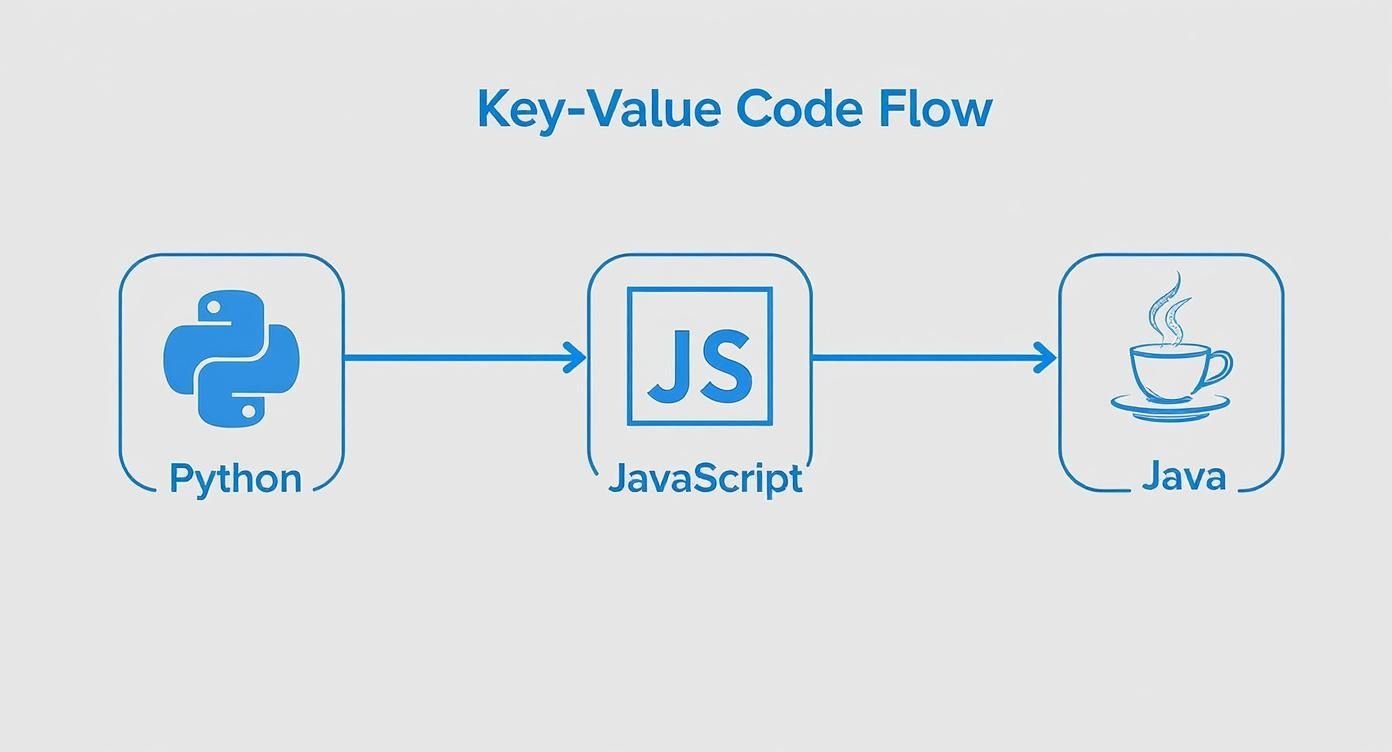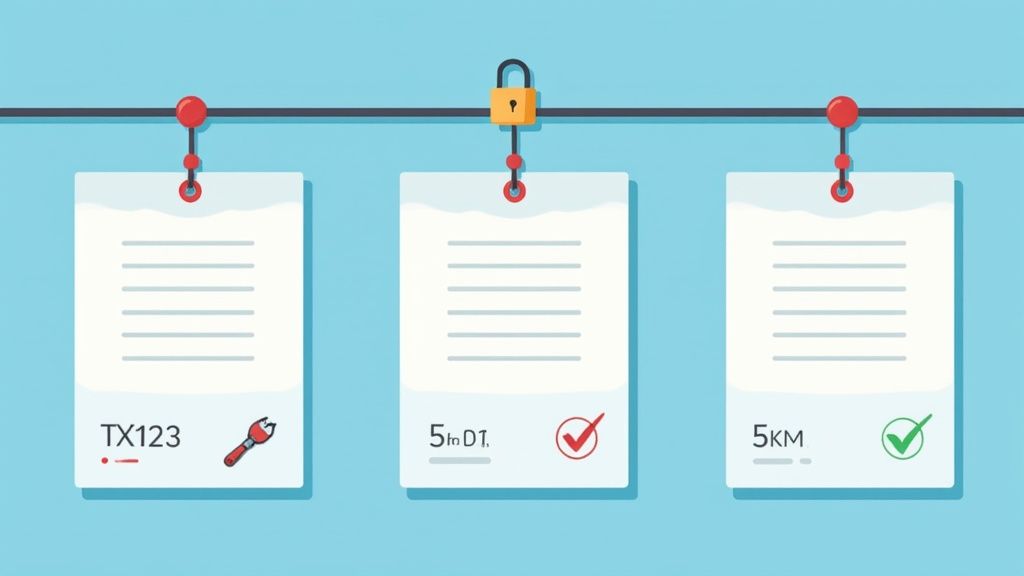Your Guide to the Key Value Pair Data Model
Discover what a key value pair is and why it's a cornerstone of modern data. Explore practical examples, use cases, and how this model drives performance.
At its core, a key-value pair is a brilliantly simple yet powerful way to organise data. For a platform like Mintline, which deals with vast amounts of financial information, this model is the bedrock of our system. Think of it like a real-world dictionary: you look up a unique word (the key) to find its definition (the value). This two-part structure is one of the most fundamental and efficient ways to store and retrieve information.
What Is a Key-Value Pair in Simple Terms

Let's use a common example from Mintline's world: a business transaction. Each transaction has a unique ID, which acts as the key. When you look up that ID, you instantly get all its associated information—the value, which might include the vendor name, the amount, the date, and a link to the receipt image. You don't have to scroll through every single entry in your ledger; you just use the transaction ID (the key) to fetch the details directly.
This direct-lookup model is exactly what makes the key-value pair so effective. It creates a simple, one-to-one relationship between a unique identifier and its corresponding data. This simplicity is its greatest strength, forming the backbone of countless applications, including Mintline’s automated financial reconciliation platform.
The Building Blocks of a Pair
Every key-value pair is made of two connected elements:
- The Key: This is a unique identifier for a specific piece of data. To avoid any mix-ups, it must be one-of-a-kind within a single dataset, much like no two invoices should share the exact same number.
- The Value: This is the actual data linked to the key. It can be something simple, like a number or a line of text, or something more complex, like a list or even another set of key-value pairs containing full receipt details.
This model has become foundational to modern data management. In the Netherlands, for instance, the accelerated push for digital transformation has highlighted the need for this kind of efficient data processing. The share of investment in data science and related technologies—many of which lean heavily on key-value structures—grew to 12% of total business investment in 2017, a noticeable jump from 8% in 2006. You can explore more on this trend in Dutch data investment.
A key-value pair is more than just a technical term; it’s a way of thinking about data. It forces you to give every piece of information a unique identifier, which brings clarity and enables incredibly fast retrieval.
For a business like Mintline, this concept is absolutely central. We use a unique transaction ID as a key to instantly pull up all the corresponding receipt details—the value. This simple pairing makes automated financial reconciliation not just possible, but also fast and incredibly reliable.
The Three Pillars of Key-Value Pair Performance

The incredible speed and dependability of key-value pairs aren't just a happy accident. They’re built on three core properties that work in concert: uniqueness, immutability, and hashing. At Mintline, these pillars are essential for building a fast, secure, and auditable financial platform.
Each pillar has a specific job. Uniqueness keeps the data clean, immutability provides stability, and hashing is the secret sauce for lightning-fast lookups. Together, they form a system that’s as robust as it is efficient.
Uniqueness Guarantees Precision
The golden rule of any key-value system is that every single key must be unique within its collection. Think of it like an invoice number—there can only be one "INV-123" for a specific vendor, which makes sure payments are applied to the right bill. In the same way, a unique key ensures that when you ask for a piece of data, you get precisely the value you expect, with no mix-ups.
This strict rule gets rid of any ambiguity and stops data from getting corrupted. At Mintline, if two different receipts somehow ended up with the same transaction ID, our entire system would be compromised. Enforcing unique keys gives us a clean one-to-one relationship between a transaction and its proof, which is absolutely vital for building accurate, auditable records.
Immutability Creates Stability
While it's not a hard-and-fast rule everywhere, keys are generally treated as immutable—meaning once they're created, they don't change. Just imagine the chaos if your bank account number changed every few years; it would be a nightmare for your financial records. Immutability gives your data a permanent, reliable reference point.
If you need to update the information, you don’t go back and edit the key. Instead, you either assign a new value to the existing key or, more commonly, you create a brand-new key-value pair. This practice protects the integrity of your data store, making sure that when you look up a past transaction, it’s exactly where you left it.
A key-value pair is a bit like a contract: the key is the agreed-upon identifier, and the value is the information it points to. Keeping the key immutable ensures the terms of that "contract" don't suddenly shift, giving you a stable foundation to build on.
Hashing Enables Instant Access
The final pillar, hashing, is the magic behind the model's impressive speed. Hashing is a clever process where an algorithm takes your key—say, a long transaction ID string—and crunches it down into a unique, fixed-size numerical address. This address tells the system the exact spot in memory to find the corresponding value, completely skipping the tedious process of searching through the entire dataset.
It’s like having a flawless index for a gigantic library. Instead of wandering through every aisle, the index points you straight to the right row and shelf. This is what allows Mintline to retrieve transaction data in what we call "constant time," meaning the search is just as fast whether you have ten records or ten million.
Seeing Key-Value Pairs in Action: Real-World Code
Theory is great, but seeing how a concept works in practice is where it really clicks. The key-value pair isn't some abstract computer science idea; it's a workhorse data structure that developers use every single day. Whether you're building a simple script or a complex financial platform like Mintline, you're almost certainly using them.
Let's dive into some code to see how this plays out. We'll look at how to create, read, update, and delete (often called CRUD operations) data using common key-value structures.
Python: The All-Powerful Dictionary
In the world of Python, the go-to implementation for key-value pairs is the dictionary, easily recognised by its curly braces {}. It's incredibly versatile and probably one of the most frequently used data types for grouping related pieces of information.
Imagine you're managing invoice data at Mintline. A dictionary is the perfect tool for the job.
Create a dictionary to hold invoice data
invoice_data = { "invoice_id": "INV_5678", "vendor": "Supplier Co.", "status": "paid" }
Reading a value is as simple as referencing its key
print(invoice_data["vendor"]) # Output: Supplier Co.
Need to update a value? Just assign a new one to the key.
invoice_data["status"] = "archived"
You can also remove a pair entirely
del invoice_data["status"]
print(invoice_data)
Output: {'invoice_id': 'INV_5678', 'vendor': 'Supplier Co.'}
JavaScript: Objects Rule the Web
JavaScript, the language that powers virtually every interactive website, uses objects for its key-value implementation. The syntax feels very similar to Python's dictionaries, which makes it easy for developers to switch between the two.
Let's say you're handling transaction information in a user dashboard.
// Create a JavaScript object for a transaction let transaction = { transactionId: "txn_abc", amount: 49.99, currency: "EUR" };
// Access a value using dot notation console.log(transaction.amount); // Output: 49.99
// Update a value transaction.currency = "USD";
// Delete a property (the key-value pair) delete transaction.currency;
console.log(transaction); // Output: { transactionId: "txn_abc", amount: 49.99 }
Java: Performance with HashMaps
In Java, a popular and powerful choice for key-value storage is the HashMap. It's a core part of the Java Collections Framework and is built for one thing above all: speed. The setup is a bit more formal, as you have to declare the data types for both the key and the value upfront.
A HashMap is an excellent choice when performance is critical. Its underlying use of hashing allows for nearly constant-time retrieval, making it ideal for managing large sets of data where lookup speed is a top priority.
Here’s how you might use it to manage application configuration settings.
import java.util.HashMap;
// Create a HashMap with String keys and String values HashMap<String, String> appConfig = new HashMap<>();
// Add key-value pairs using the 'put' method appConfig.put("api_key", "xyz123abc"); appConfig.put("language", "en_GB");
// Read a value with the 'get' method String apiKey = appConfig.get("api_key"); // "xyz123abc"
// Updating is just 'put' again with the same key appConfig.put("language", "nl_NL");
// Remove a pair appConfig.remove("api_key");
System.out.println(appConfig); // Output: {language=nl_NL}
These practical examples show just how versatile the key-value model is. This same fundamental structure helps us at Mintline process financial documents with incredible efficiency. You can learn more about how we apply these principles by reading our guide on intelligent document processing.
How Key Value Data Is Stored and Retrieved
Okay, so we've covered what a key-value pair is and seen it in action. But where does this data actually live? That’s the next critical piece of the puzzle. The way you store it has a massive impact on how quickly and reliably your application can get to its information. The options range from temporary, lightning-fast in-memory solutions to powerful, permanent databases built to handle enormous scale.
This infographic breaks down the typical workflow for using key-value pairs, which is remarkably consistent no matter which programming language you're using.

As you can see, the basic structure doesn't change, which is a big part of why it's such a versatile and predictable data model for developers at Mintline and beyond.
Quick Access with In-Memory Storage
The most straightforward way to store key-value data is in-memory, using native structures like Python dictionaries or Java’s HashMaps. This literally means the data is held in your application’s RAM. Because RAM is incredibly fast, pulling a value is almost instantaneous. This makes it perfect for temporary data, like caching application settings or storing the details of a user’s current session.
But that speed comes at a price: volatility. If the application crashes or the server reboots, all that in-memory data is gone for good. Think of it like writing notes on a whiteboard—it’s brilliant for the meeting you’re in, but it gets wiped clean afterwards. This makes it a non-starter for critical information that absolutely must be preserved, such as the financial records Mintline is responsible for.
Persistent Power with Key Value Databases
When data needs to stick around and handle serious traffic, we turn to dedicated key-value databases. You might also hear these called key-value stores. Systems like Redis and Amazon DynamoDB are purpose-built to manage huge volumes of key-value pairs while delivering exceptional performance. They store data on a disk, which means it survives reboots, power cuts, and system failures.
These databases are the workhorses behind countless high-performance applications. They give you the super-fast lookup speed of an in-memory map combined with the durability you'd expect from a traditional database. For a platform like Mintline, this means we can use a key-value store to instantly pull up a client's entire transaction history using nothing more than their unique customer ID as the key.
A key-value database offers the best of both worlds: the direct, simple access of a dictionary, plus the persistence and scalability needed to support enterprise-grade applications handling millions of records.
The Netherlands has long recognised the power of this model, particularly in its tech and financial sectors. Dutch institutional research has confirmed that key-value stores are a dominant data management method in large-scale systems. One notable study found these systems could process up to 10,000 operations per second, making them ideal for high-traffic environments. Critically, implementing versioned key-value stores in the Netherlands has been shown to cut data conflicts in distributed applications by 40%, a significant boost to system reliability. You can read more about these KVS findings in the full research paper.
Transmitting Data with JSON
Finally, what happens when key-value data needs to travel across a network, say from a server to a web browser? It needs a standard format that both sides can understand. JSON (JavaScript Object Notation) is the universal language for this job. It’s a lightweight, human-readable text format that perfectly mirrors key-value structures.
Because it’s so simple and easy for machines to parse, JSON has become the de facto standard for APIs across the globe. When Mintline’s platform sends receipt data to your user dashboard, it's almost certainly packaged up as a JSON object, ensuring it arrives intact and ready to be displayed.
Building Audit-Ready Systems with Key-Value Pairs

This is where the simple concept of a key-value pair goes from a technical detail to a powerful business advantage. For a financial platform like Mintline, its value isn't just about speed; it's about building systems that are transparent, secure, and ready for scrutiny at a moment's notice. The core principles of uniqueness and immutability are what make this possible.
Every single transaction that flows through our system gets its own unique identifier, which acts as the key. That key is then permanently linked to its matching receipt or invoice—the value. What you get is an unbreakable, one-to-one connection between a financial event and its proof. No ambiguity, no room for error.
An audit trail is, at its heart, a collection of key-value pairs. Each key represents a unique event ('who did what, and when'), while the value holds the unchangeable proof. This structure is the very essence of verifiable accounting.
This straightforward but incredibly robust data model is how we build a system where every piece of financial data is meticulously organised and instantly retrievable. It's a cornerstone of the service we provide to our clients.
Creating an Immutable Ledger
At Mintline, we use the key-value model to construct an immutable log of all financial activities. You can think of it as a digital ledger where every single entry is written in permanent ink. Once a transaction receipt is matched and recorded, it cannot be altered or misplaced.
This approach guarantees complete data integrity. When audit season rolls around, you can present a clean, verifiable record of every transaction with absolute confidence. The process is quite simple:
- Unique Transaction ID (Key): A unique identifier, something like
txn_20240921_1A4B7C, is generated for a bank transaction. - Receipt Data (Value): The corresponding receipt, with all its vendor details, date, and amount, is digitised and stored as the value.
- Permanent Linkage: The key and value are then bound together in our system, creating a permanent, unchangeable record of that financial event.
Storing Asset Metadata Securely
We don't just stop at transactions; we apply the same logic to managing crucial asset metadata. For instance, every document uploaded to Mintline—whether it's a bank statement or a supplier invoice—is stored with its own set of key-value pairs.
"document_id": "doc_xyz789""upload_timestamp": "2024-09-21T10:30:00Z""file_hash": "a1b2c3d4...""user_id": "usr_54321"
This detailed metadata gives us a crystal-clear and traceable history for every single document. It proves precisely when a file was added, who added it, and that it hasn't been tampered with since. This is fundamental to delivering the security and clarity our clients depend on.
By combining this structured approach with smart automation, we bring a new level of precision to financial management. You can learn more about how technology is shaping this field in our post on the role of AI in accounting. This meticulous record-keeping is how we turn chaotic financial admin into a streamlined, audit-ready process.
The Unseen Power of This Simple Data Model
It turns out the humble key-value pair is a true giant in the world of data. Its greatest strength lies in its simplicity, which is exactly what gives modern software the speed, scalability, and flexibility it needs to function.
This simple model is everywhere, from powering a website’s cache to forming the backbone of massive distributed databases. Its efficiency is undeniable. For anyone working in technology, getting to grips with this fundamental building block isn't just useful—it's essential.
A great local example is how Dutch open data initiatives, like those from Statistics Netherlands, use key-value formats to share public information. In 2023 alone, this model helped them handle over 1.2 million API requests, making data more accessible and transparent for everyone. You can read more about the Dutch open data services to see it in action.
The real takeaway here is that the most powerful solutions are often the simplest. This straightforward data model is the foundation for countless reliable, high-performance systems.
This foundational reliability is precisely what allows platforms like Mintline to deliver exceptional performance and security. By mastering simple yet potent concepts, we build robust, audit-ready systems that automate incredibly complex financial tasks. This same principle is explored in our article on optimising workflows with straight-through processing, where clarity at the foundation leads to huge gains in efficiency.
The key-value pair is a perfect reminder that you don't always need complexity to achieve power.
Got Questions? We've Got Answers
Even after breaking down the basics, you might still have a few questions about how key-value pairs work in the real world. Let's tackle some of the most common ones to really cement your understanding.
Think of this as the practical Q&A session, clearing up the 'why' and 'when' behind this powerful data structure.
Key-Value Pair vs. Array: What’s the Real Advantage?
The biggest win for a key-value pair over a standard array is direct, meaningful access. You can pull out a specific piece of data almost instantly just by using its unique key. It's the difference between asking for "Invoice INV-123" versus shouting "hey, you, item number 47!"
With an array, you often have to loop through all the items until you find what you need, or you must know the exact numerical index. That gets inefficient fast, especially with large datasets where a simple number like 7 or 123 doesn't tell you anything about the data it points to.
Can the Value Be Something More Complex?
Absolutely, and that’s where the magic really happens. A value isn’t limited to a simple number or a bit of text like "status": "active". It can hold much richer information.
Think of a key as unlocking either a single coin or an entire treasure chest. The 'value' in a key-value pair can be a list, a structured JSON object, or even another set of nested key-value pairs. This makes the model incredibly adaptable.
At Mintline, for example, the key might be a transaction ID, but the value is a complex object containing the vendor, amount, date, line items from the receipt, and a link to the document image. This flexibility is crucial for building detailed financial records.
When Is a Key-Value Store the Wrong Tool for the Job?
As handy as they are, key-value pairs aren't a silver bullet. You'll want to reach for a different tool when you're dealing with data that has lots of intricate relationships.
Key-value stores aren't built for tasks that involve:
- Complex queries that need to filter and search across many different records at once.
- Joining data from different "tables" to pull together a complete picture.
- Transactions that require updating multiple, separate records together as a single, all-or-nothing operation.
For that kind of relational work, a traditional SQL database is almost always the better fit. It’s specifically designed to manage the web of connections between different data points, something a key-value store just isn't meant to do.
At Mintline, we harness the power of key-value pairs to build secure, auditable financial records. Every single transaction is locked to its proof with a clear, unchangeable link. See how we make complex accounting simple and automated at https://mintline.ai.
